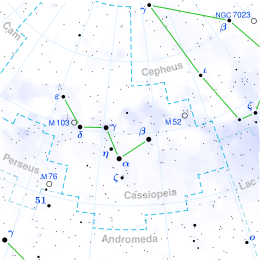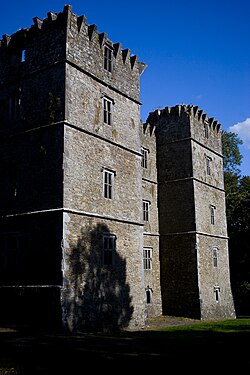피카시오페이아과
Phi Cassiopeiae| 관측 데이터 신기루J2000.0이쿼녹스J2000.0 | |
|---|---|
| 별자리 | 카시오페이아 |
| A | |
| 우측 상승 | 01h 20m 04.917s[1] |
| 탈위임 | +58° 13′ 53.80″[1] |
| 겉보기 크기(V) | +5.11[2] |
| C | |
| 우측 상승 | 01h 19m 51.737s[1] |
| 탈위임 | +58° 11′ 29.32″[1] |
| 겉보기 크기(V) | +7.08[2] |
| 특성. | |
| A | |
| 스펙트럼형 | F0IA[2] |
| U-B색지수 | +0.49[3] |
| B-V색지수 | +0.68[3] |
| C | |
| 스펙트럼형 | B6Ib[2] |
| U-B색지수 | −0.37[3] |
| B-V색지수 | +0.41[3] |
| 아스트로메트리 | |
| A | |
| 방사 속도(Rv) | -28.39km[4]/s |
| 적정운동(μ) | RA: -0.516마스[5]/yr Dec.: −1.556[5]mas/yr |
| 시차(시차) | 0.2460 ± 0.1091 마스[5] |
| 거리 | 약 13,000리 (약 4000pc) |
| 절대치수(MV) | −8.76[6] |
| C | |
| 방사 속도(Rv) | -28.50km[7]/s |
| 적정운동(μ) | RA: −1.423[8]mas/yr Dec.: −0.681[8]mas/yr |
| 시차(시차) | 0.2432 ± 0.0309 마스[8] |
| 거리 | 약 13,000리 (약 4,100pc) |
| 절대치수(MV) | −6.5[9] |
| 세부 사항 | |
| A | |
| 미사 | 6.3[10] M☉ |
| 반지름 | 263[10] R☉ |
| 루미도 | 170,000[10] L☉ |
| 표면 중력(log g) | 1.0[6] cgs |
| 온도 | 7,341[6] K |
| 금속성 | -0.24[6] |
| 회전 속도(v sin i) | 시속 23km[11] |
| 나이 | 20MYR[12] |
| C | |
| 미사 | 21[9] M☉ |
| 반지름 | 53[9] R☉ |
| 루미도 | 83,000[13] L☉ |
| 표면 중력(log g) | 2.05[13] cgs |
| 온도 | 15,500[13] K |
| 회전 속도(v sin i) | 초속[13] 35km/s |
| 기타 지정 | |
| A: HD 7927, HIP 6242, BD+57°260, SAO 22191, GC 1594 | |
| C: HD 7902, HIP 6229, BD+57°257, SAO 22187, GC 1590, NSV 466 | |
| 데이터베이스 참조 | |
| 심바드 | 자료 |
피 카시오페이아자리(Phi Cassiopeiae, φ Cassiopeiaae)는 카시오페이아 별자리에 있는 별이다.φ 카시오페이아이는 겉보기 크기를 합친 +4.95의 복수 항성이다.가장 밝은 두 성분은 A와 C인데, 때로는 φ과1 φ2 Cas라고 불린다.φ Cas A는 진도 4.95의 F0 밝은 초거성이고, Cas C는 진도 7.08 B6의 초거성 134"이다.
시스템

③ 카시오페이아에(Cassiopeiae)는 2400pc에 있는 열린 성단 NGC 457의 별 가운데 나타나지만 성단의 구성원인지는 불확실하다.[12]φ Cas는 일반적으로 가장 밝은 별과의 거리 순서로 A~E로 지정된 성분 별 5개를 갖는 것으로 처리된다.두 성분 A와 C는 NGC 457의 가장 밝은 성분으로, φ과12 i 카시오페이아에라고 부르기도 한다.[14]성분 B는 φ에서1 진폭 49" 12번째 별이다.성분 D와 E와 두 가지 성분 B-형 주계열성은 NGC 457에서 모두, 성분 E는 φ에서2 42"에 불과하다.다른 세 가지 구성요소는 때때로 복수 시스템의 구성요소로 나열되지만, 이는 다소 임의적이어서 몇 아크 분 내에 NGC 457의 수십 개 구성원이 발견된다.[15]
이 두 초거성은 NGC 457의 다른 별들과 유사한 우주 운동을 공유하지만, 진화 상태와 밝기는 그들을 거의 구성원으로 만들지 못하게 한다.[10]그들의 가이아 데이터 릴리즈 2 시차축은 성단의 다른 별들과 견줄 만하며 NGC 457의 허용 거리와 일치한다.[16]
특성.
φ은1 매우 밝은 노란색 초거성이다.그것의 절대 크기는 일부 황색 초기성 물질과 비슷하지만, 그것은 그것을 초기성 물질 그 자체로 적격할 대량 손실과 불안정성의 수준을 보여주지 않는다.다양한 모델 대기 모두 온도가 7,300K, 낮은 표면 중력, 반지름 250을 나타낸다.R☉, 그리고 10만개가 훨씬 넘는 광도L더 불확실한 것은 25를 훨씬 넘었을 것으로 예상되는 질량이다☉.M☉ 처음에는 그랬지만 지금은 훨씬 덜했다.다른 작가들이 6가지로부터 가치를 출판했다.M☉ 열일곱까지M☉.[10][17]
φ은2 비교적 전형적인 B급 초거성으로 태양의 8만 3천 배다.그것은 의심스러운 변수와 분광형 이항이다.[18]
참고 항목
참조
- ^ a b c d Van Leeuwen, F. (2007). "Validation of the new Hipparcos reduction". Astronomy and Astrophysics. 474 (2): 653–664. arXiv:0708.1752. Bibcode:2007A&A...474..653V. doi:10.1051/0004-6361:20078357. S2CID 18759600.
- ^ a b c d Eggleton, P. P.; Tokovinin, A. A. (2008). "A catalogue of multiplicity among bright stellar systems". Monthly Notices of the Royal Astronomical Society. 389 (2): 869. arXiv:0806.2878. Bibcode:2008MNRAS.389..869E. doi:10.1111/j.1365-2966.2008.13596.x. S2CID 14878976.
- ^ a b c d Ducati, J. R. (2002). "VizieR Online Data Catalog: Catalogue of Stellar Photometry in Johnson's 11-color system". CDS/ADC Collection of Electronic Catalogues. 2237. Bibcode:2002yCat.2237....0D.
- ^ Mermilliod, J. C.; Mayor, M.; Udry, S. (2008). "Red giants in open clusters. XIV. Mean radial velocities for 1309 stars and 166 open clusters". Astronomy and Astrophysics. 485 (1): 303–314. Bibcode:2008A&A...485..303M. CiteSeerX 10.1.1.30.7545. doi:10.1051/0004-6361:200809664.
- ^ a b c Brown, A. G. A.; et al. (Gaia collaboration) (August 2018). "Gaia Data Release 2: Summary of the contents and survey properties". Astronomy & Astrophysics. 616. A1. arXiv:1804.09365. Bibcode:2018A&A...616A...1G. doi:10.1051/0004-6361/201833051. 이 소스에 대한 가이아 DR2 기록 VizieR.
- ^ a b c d Kovtyukh, V. V.; Gorlova, N.; Belik, S. I. (2012). "Accurate luminosities from the oxygen 7771-4 a triplet and the fundamental parameters of F-G supergiants". Monthly Notices of the Royal Astronomical Society. 423 (4): 3268. arXiv:1204.4115v1. Bibcode:2012MNRAS.423.3268K. doi:10.1111/j.1365-2966.2012.21117.x. S2CID 118683158.
- ^ Kharchenko, N. V.; Scholz, R.-D.; Piskunov, A. E.; Röser, S.; Schilbach, E. (2007). "Astrophysical supplements to the ASCC-2.5: Ia. Radial velocities of ˜55000 stars and mean radial velocities of 516 Galactic open clusters and associations". Astronomische Nachrichten. 328 (9): 889. arXiv:0705.0878. Bibcode:2007AN....328..889K. doi:10.1002/asna.200710776. S2CID 119323941.
- ^ a b c Brown, A. G. A.; et al. (Gaia collaboration) (August 2018). "Gaia Data Release 2: Summary of the contents and survey properties". Astronomy & Astrophysics. 616. A1. arXiv:1804.09365. Bibcode:2018A&A...616A...1G. doi:10.1051/0004-6361/201833051. 이 소스에 대한 가이아 DR2 기록 VizieR.
- ^ a b c Leitherer, C.; Wolf, B. (1984). "Early-type stars in OB associations in the infrared. I Extinction law and IR excesses". Astronomy and Astrophysics. 132: 151. Bibcode:1984A&A...132..151L.
- ^ a b c d e Rosenzweig, P.; Anderson, L. (1993). "A determination of the basic atmospheric parameters of Phi Cassiopeiae". The Astrophysical Journal. 411: 207. Bibcode:1993ApJ...411..207R. doi:10.1086/172820.
- ^ Evans, Christopher J.; Howarth, Ian D. (2003). "Characteristics and classification of A-type supergiants in the Small Magellanic Cloud". Monthly Notices of the Royal Astronomical Society. 345 (4): 1223. arXiv:astro-ph/0308125. Bibcode:2003MNRAS.345.1223E. doi:10.1046/j.1365-2966.2003.07038.x. S2CID 15290757.
- ^ a b Zhang, X. B.; Luo, C. Q.; Fu, J. N. (2012). "B-Type Variables in the Young Open Cluster Ngc 457". The Astronomical Journal. 144 (3): 86. Bibcode:2012AJ....144...86Z. doi:10.1088/0004-6256/144/3/86.
- ^ a b c d McErlean, N. D.; Lennon, D. J.; Dufton, P. L. (1999). "Galactic B-supergiants: A non-LTE model atmosphere analysis to estimate atmospheric parameters and chemical compositions". Astronomy and Astrophysics. 349: 553. Bibcode:1999A&A...349..553M.
- ^ Mark Bratton (15 September 2011). The Complete Guide to the Herschel Objects: Sir William Herschel's Star Clusters, Nebulae and Galaxies. Cambridge University Press. pp. 583–. ISBN 978-0-521-76892-4.
- ^ Dommanget, J.; Nys, O. (1994). "Catalogue des composantes d'etoiles doubles et multiples (CCDM) premiere edition - Catalogue of the components of double and multiple stars (CCDM) first edition". Com. De l'Observ. Royal de Belgique. 115: 1. Bibcode:1994CoORB.115....1D.
- ^ Brown, A. G. A.; et al. (Gaia collaboration) (August 2018). "Gaia Data Release 2: Summary of the contents and survey properties". Astronomy & Astrophysics. 616. A1. arXiv:1804.09365. Bibcode:2018A&A...616A...1G. doi:10.1051/0004-6361/201833051.
- ^ Arellano Ferro, A.; Parrao, L.; Giridhar, S. (1988). "Comments on the variability and physical parameters of the F supergiant Phi Cassiopeiae". Astronomical Society of the Pacific. 100: 993. Bibcode:1988PASP..100..993A. doi:10.1086/132261.
- ^ Mayer, Pavel; Hanna, Magdy A.; Wolf, Marek; Chochol, Drahos (1998). "Radial velocities of six early-type evolved stars". Astrophysics and Space Science. 262 (2): 163. Bibcode:1994CoSka..24...65M. doi:10.1023/A:1001840718226. S2CID 118901569.



